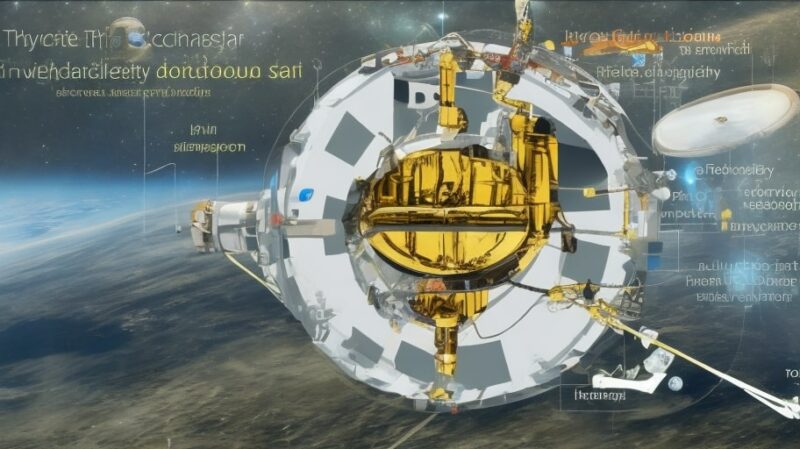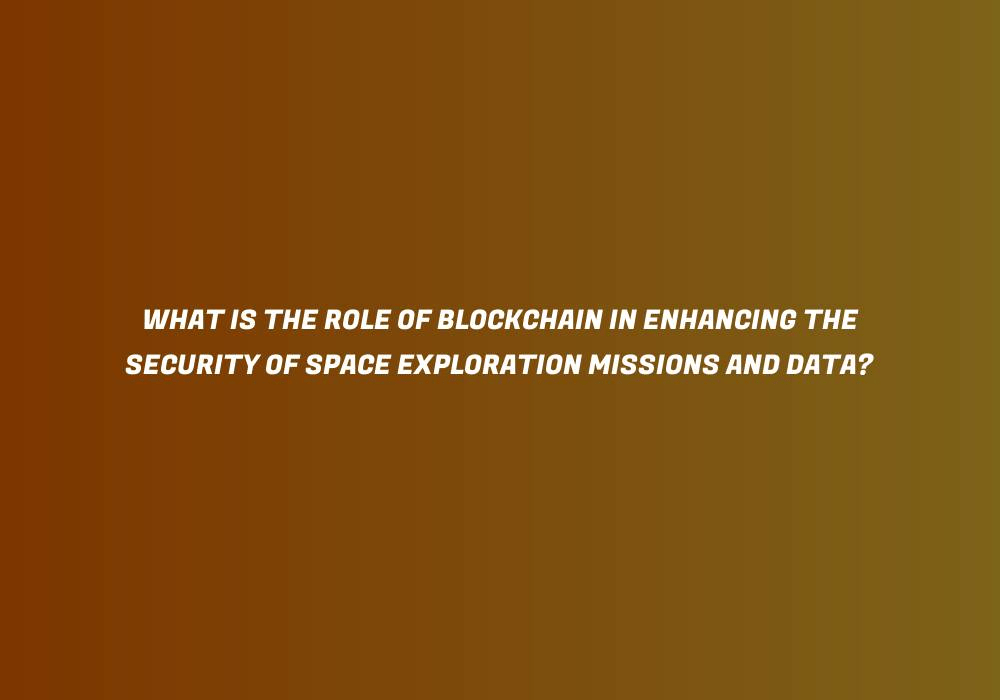Imagine a future where space exploration is not only a thrilling adventure but also a secure one. Thanks to the innovative technology of blockchain, this exciting prospect may become a reality. Blockchain, the decentralized digital ledger, has the potential to revolutionize how we safeguard the security of space exploration missions and the valuable data they generate. By providing enhanced encryption, transparency, and immutability, blockchain offers a robust solution to counteract potential threats and ensure the integrity of critical information. So, let’s embark on a journey to uncover the fascinating role of blockchain in the safeguarding of space exploration missions and data.
1. Introduction
Space exploration missions play a crucial role in expanding our understanding of the universe and pushing the boundaries of human knowledge. However, with the increasing complexity and scale of these missions, ensuring the security of both the mission itself and the critical data generated during the process has become a paramount concern. In recent years, blockchain technology has emerged as a potential solution to enhance the security of space exploration missions. Blockchain offers a decentralized and tamper-resistant platform that can mitigate vulnerabilities and risks, providing a robust foundation for secure communication, data storage, authentication, and verification. In this article, we will explore the role of blockchain in enhancing the security of space exploration missions and data, along with its potential applications, challenges, and future directions.
2. Understanding Blockchain Technology
2.1 Definition of Blockchain
Blockchain is a distributed ledger technology that enables the secure and transparent recording of transactions or data across multiple network participants. The information is stored in blocks that are linked together in a chronological chain, creating an immutable and tamper-proof record. Each participant in the network holds a copy of the blockchain, ensuring transparency and preventing any single point of failure.
2.2 How Blockchain Works
Blockchain operates on a peer-to-peer network, where each participant, commonly known as a node, maintains a copy of the entire blockchain. When a new transaction or data entry is proposed, it is validated by the network through a consensus mechanism, such as proof-of-work or proof-of-stake. Once validated, the transaction is added to a new block and linked to the previous block, creating a permanent and transparent record. This decentralized approach eliminates the need for intermediaries, reducing the risk of data manipulation or unauthorized access.
2.3 Properties of Blockchain
Blockchain offers several key properties that make it suitable for enhancing the security of space exploration missions. Firstly, it provides immutability and tamper-proof data storage, ensuring the integrity and authenticity of critical mission data. Secondly, the decentralized nature of blockchain reduces the vulnerability to single points of failure, enhancing the resilience of the mission systems. Lastly, the transparency and auditability of blockchain enable traceability and accountability, crucial for ensuring the integrity of space exploration data.
3. Importance of Security in Space Exploration Missions
3.1 Vulnerabilities and Risks
Space exploration missions face numerous vulnerabilities and risks that can compromise the integrity, confidentiality, and availability of mission-critical data. Malicious attacks, such as cyber-attacks or data breaches, can lead to unauthorized access, tampering, or theft of sensitive information. Moreover, the communication links between mission control and spacecraft are exposed to interference or interception, posing a significant risk to the success of the mission.
3.2 Need for Enhanced Security
Considering the high stakes involved in space exploration missions, it is essential to enhance the security measures to protect the integrity and confidentiality of the data. By leveraging blockchain technology, space agencies and organizations can establish a secure and robust framework that mitigates vulnerabilities and ensures the trustworthiness of critical systems and data. The decentralized nature of blockchain eliminates single points of failure and provides an added layer of protection against unauthorized access or manipulation.
4. Blockchain Applications in Space Exploration Missions
4.1 Decentralized Storage of Mission Data
Blockchain can serve as a decentralized storage solution for mission data. Traditional centralized storage systems are vulnerable to data breaches, physical damage, or system failures. By storing mission-critical data on a blockchain network, space agencies can ensure the integrity and availability of the data. The immutability of blockchain eliminates the risk of unauthorized tampering, while the decentralized nature ensures that data remains accessible even in the event of a system failure or cyber-attack.
4.2 Secure Communication and Data Transfer
Blockchain technology can enhance the security of communication and data transfer between mission control and spacecraft. By encrypting the communication channels and leveraging blockchain’s tamper-proof properties, space agencies can significantly reduce the risk of interception or unauthorized access to sensitive information. The transparent and auditable nature of blockchain enables real-time monitoring and detection of any suspicious activities, allowing for timely response and mitigation.
4.3 Authentication and Verification
Authentication and verification of data and entities are critical in space exploration missions, especially when dealing with confidential or sensitive information. Blockchain-based identity management systems can provide a robust mechanism for ensuring the authenticity and integrity of participants in the mission. By leveraging cryptographic techniques and decentralization, blockchain enables secure and tamper-proof authentication, minimizing the risk of impersonation or unauthorized access.
4.4 Tracking and Traceability
Blockchain can also facilitate the tracking and traceability of space exploration equipment, assets, and resources. By creating digital records on the blockchain, space agencies can maintain a transparent and auditable trail of ownership, location, and maintenance history. This not only improves accountability but also reduces the risk of equipment loss or unauthorized use. Additionally, blockchain can be leveraged for supply chain management in space missions, ensuring the authenticity and integrity of critical components and materials.
5. Role of Blockchain in Enhancing Data Security

5.1 Immutable and Tamper-Proof Data Storage
One of the key features of blockchain technology is its immutability and tamper-proof nature. Once data is recorded on the blockchain, it cannot be altered or deleted without consensus from the network participants. This property makes blockchain highly suitable for ensuring the integrity and authenticity of space exploration data. By storing mission-critical data on the blockchain, space agencies can establish a robust and transparent framework that prevents unauthorized modification or tampering, thereby enhancing overall data security.
5.2 Encryption and Privacy
Blockchain can be combined with encryption techniques to provide enhanced privacy and confidentiality for space exploration data. Encryption ensures that only authorized parties can access and interpret the data, protecting it from unauthorized disclosure or interception. By encrypting the data before recording it on the blockchain, space agencies can maintain the confidentiality of sensitive information throughout the entire mission lifecycle.
5.3 Smart Contracts for Secure Transactions
Smart contracts, which are self-executing contracts with predefined conditions and actions, can enhance the security of transactions in space exploration missions. By leveraging blockchain’s decentralized and tamper-proof nature, smart contracts enable secure and automated transaction processes, eliminating the need for intermediaries and reducing the risk of fraud or human error. For example, smart contracts can be used to automate payment processes between space agencies and service providers, ensuring timely and secure transactions.
6. Blockchain for Mission Control and Data Centers
6.1 Securing Mission Control Systems
Mission control systems are at the core of space exploration missions, handling critical operations and data management. Blockchain can enhance the security of mission control systems by providing a decentralized and tamper-proof platform for data storage, communication, and authentication. By leveraging blockchain, mission control systems can mitigate vulnerabilities, such as unauthorized access or data manipulation, ensuring the reliability and trustworthiness of the systems.
6.2 Protecting Data Centers and Servers
Data centers and servers that house mission-critical data are prime targets for cyber-attacks or physical breaches. Blockchain can enhance the security of these facilities by decentralizing the storage of data and leveraging cryptographic techniques for encryption and authentication. By distributing the data across multiple nodes in the network, blockchain reduces the risk of data loss or unauthorized access. Moreover, blockchain’s tamper-proof nature ensures the integrity and authenticity of data stored in these facilities.
7. Challenges and Limitations of Blockchain in Space Exploration
7.1 Scalability and Performance
One of the main challenges of blockchain technology is scalability and performance. The process of validating transactions and adding them to the blockchain can be resource-intensive and time-consuming, leading to potential bottlenecks in processing large volumes of data. This scalability limitation can be particularly challenging in space exploration missions that generate vast amounts of data in real-time. However, ongoing research and advancements in blockchain technology aim to address these scalability issues and improve performance.
7.2 Energy Consumption
Blockchain networks, especially those based on proof-of-work consensus mechanisms, require substantial computational power and energy consumption. This energy-intensive nature of blockchain can pose challenges in space exploration missions, where energy efficiency is critical for long-duration missions. Developing energy-efficient blockchain solutions or exploring alternative consensus mechanisms, such as proof-of-stake, can help mitigate this limitation.
7.3 Integration and Compatibility Issues
Integrating blockchain technology into existing space exploration systems and infrastructures can be complex and challenging. Legacy systems may have compatibility issues with blockchain, requiring significant modifications or updates. Moreover, blockchain interoperability with different networks or protocols can also pose challenges in establishing seamless communication and data exchange. Addressing these integration and compatibility issues is crucial for the successful implementation of blockchain in space exploration missions.
8. Future Potential and Research Directions
8.1 Advancements in Blockchain Technology
Blockchain technology is still in its infancy, and ongoing research and development are continuously pushing the boundaries of its capabilities. Advancements in blockchain scalability, interconnectivity, and energy efficiency will open new doors for its application in space exploration missions. Moreover, exploring novel consensus mechanisms and privacy-enhancing techniques will further enhance the security and privacy aspects of blockchain in space missions.
8.2 Collaborative Efforts and Partnerships
Collaborative efforts and partnerships between space agencies, technology companies, and academic institutions are crucial for advancing the role of blockchain in space exploration missions. By leveraging collective expertise and resources, collaborative initiatives can accelerate the development and adoption of blockchain-based solutions for enhancing mission security and data integrity. These partnerships also facilitate knowledge exchange and foster innovation in the space technology sector.
8.3 Addressing Limitations and Challenges
Further research and development are required to address the limitations and challenges of blockchain technology in space exploration missions. Robust solutions for scalability, energy efficiency, and integration with existing systems need to be explored and implemented. Additionally, regulatory frameworks and standards specific to blockchain in space exploration missions must be developed to ensure compliance, interoperability, and security.
9. Conclusion
Blockchain technology offers a promising platform for enhancing the security of space exploration missions and data. Its decentralized and tamper-proof nature provides a robust foundation for secure communication, data storage, authentication, and verification. By leveraging blockchain, space agencies and organizations can mitigate vulnerabilities, ensure data integrity, and enhance the resilience of critical systems. While challenges and limitations exist, ongoing advancements in blockchain technology, collaborative efforts, and research directions pave the way for a future where blockchain plays a significant role in safeguarding the integrity and security of space exploration missions and their valuable data.
